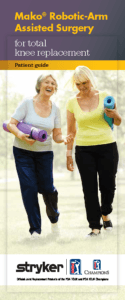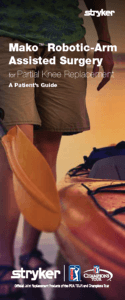Robotic Assisted Total Knee Replacement
 Total knee replacement (TKR) and partial knee replacement surgery is considered for painful osteoarthritis of the knee when non-operative treatment fails to control the patient’s symptoms. Knee replacement surgery involves resurfacing the damaged arthritic surfaces with implants typically made of metal alloys and strong plastic (polyethylene).
Total knee replacement (TKR) and partial knee replacement surgery is considered for painful osteoarthritis of the knee when non-operative treatment fails to control the patient’s symptoms. Knee replacement surgery involves resurfacing the damaged arthritic surfaces with implants typically made of metal alloys and strong plastic (polyethylene).
The knee has three compartments – medial (inside), lateral (outside), and patellofemoral (kneecap). Partial knee replacement is performed when only one of the knee compartments is arthritic. A total knee replacement is performed when 2 or more of the knee compartments are arthritic.
Robotic-assisted TKR and partial knee replacement provides a precise customized plan based on a preoperative CT scan. The CT scan is combined with real time navigation of the patient’s specific bone anatomy during surgery to provide accurate and consistent implant size and position. Ideal implant size and position leads to better function and longer lasting joint replacement.
The robotic arm is controlled by the surgeon and works in a predefined area based on the patient’s personalized pre-operative plan. If the robotic arm strays, it stops working, protecting surrounding tissues. Fine-tuned adjustments can be made during surgery based on real-time feedback provided by the computer navigation screens.
Robotic-assisted TKR and partial knee replacement is believed to provide improved precision of implant position and size leading to better function and longevity of the knee replacement.




